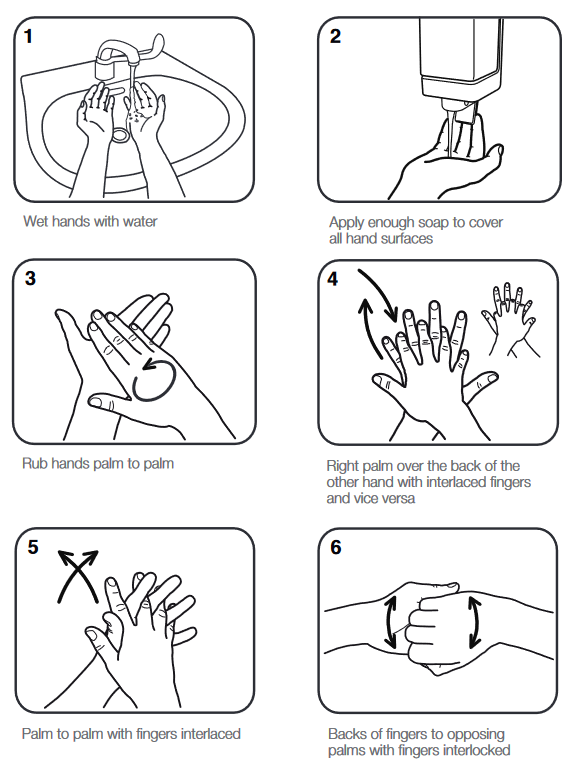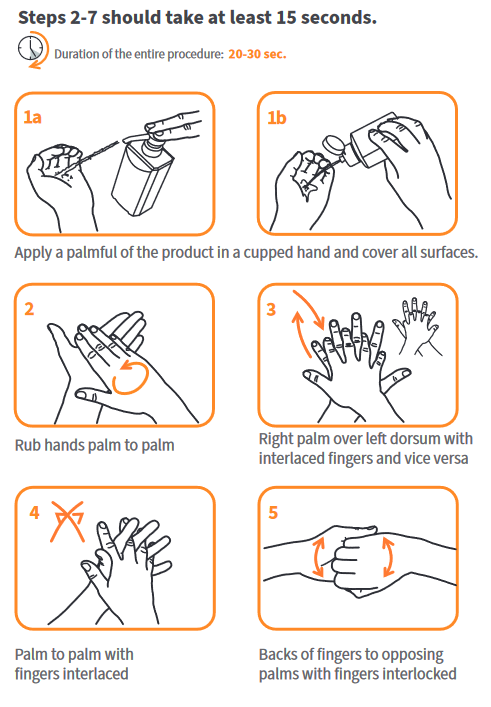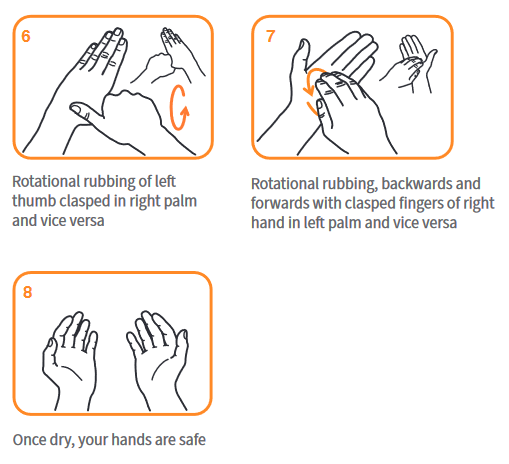- Expose your forearms.
- Remove all hand /wrist jewellery (a single, plain metal finger ring is permitted but should be removed or moved up during hand hygiene).
- Ensure finger nails are clean, short and that artificial nails or nail products are not worn.
- Cover all cuts or abrasions you have with a waterproof dressing.
Hand hygiene

Hand hygiene is considered an important practice to prevent the spread of infections.
Hand rub is the preferred product for hand hygiene in health and social care settings unless hands are visibly contaminated/ soiled, or when there is likely to be exposure to spore forming organisms (germs/bugs) Clostridioides difficile (C. difficile) or infectious diarrhoeal diseases (Norovirus). In these circumstances hands should be washed with liquid soap and warm water.
The application of hand rubs should be sufficient in volume to cover all surfaces of the hands and rubbed in until dry – see hand rubbing actions below.
NOTE: Hand rubs are not effective against gastrointestinal (stomach) infections such as Clostridioides difficile (C. difficile) or Norovirus, so if the person you are caring for has diarrhoea or vomiting it is recommended that hands are washed with liquid soap and warm water.
When you have no access to running water, liquid soap, clean towel or disposable paper towels when delivering care in a person’s home, it is advised that you carry your own liquid soap and disposable paper towels. If this is not possible antimicrobial hand wipes are permitted and you should perform hand hygiene using hand rub immediately after using the hand wipes and perform hand hygiene with soap and water at the first available opportunity.
ALWAYS carry out hand hygiene:
- before touching a person
- before clean/aseptic technique
- after body fluid exposure
- after touching a person
- after touching a person’s immediate surroundings
- before handling medication
- before preparing/serving food
- after visiting the toilet
- before putting on and removing PPE
- between carrying out different care activities on the same person
- after cleaning care equipment
- after disposing of an individual's personal waste
- after handling dirty linen.
Remember:
- Hands are covered in microorganisms (germs/bugs) - even if they look clean.
- Hand hygiene is the most effective thing you can do to reduce the spread of infection.
- Alcohol based hand rub can also be used in appropriate circumstances (as noted before).
- When you have no access to running water, liquid soap, a clean towel or disposable paper towels when delivering care in a person’s home, it is advised that you carry your own liquid soap and disposable paper towels. If this is not possible, antimicrobial hand wipes are permitted. You should perform hand hygiene using hand rub immediately after using the hand wipes and perform hand hygiene with soap and water at the first available opportunity.
- Dry hands thoroughly after handwashing using disposable paper towels.
- Use an emollient hand cream regularly after washing hands for example when you are off duty or going on a break.
- Do not use or provide communal tubs of hand cream in the care setting.
- Report to line manager or occupational health if your hands become irritated and/or the integrity of your skin is broken.




